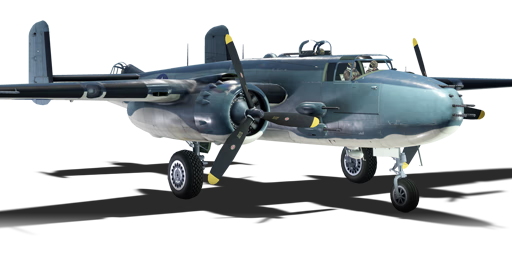



In mid-1942, the US Army Air Corps and the US Navy made an inter-service agreement; in exchange for the USN cancelling the Boeing XPBB Sea Ranger patrol flying boat and its associated Boeing Renton plant, the USAAC would transfer 202 North American B-25 Mitchells and its production plant in Kansas. This agreement was made to free up production capacity for the B-29 Superfortress, which was a high-priority project at that time. The transferred B-25s then received the designation PBJ-1 Mitchell and were assigned to patrol duties that the cancelled XPBB was originally designed for.
By mid-1943, most of the PBJ-1s were operated by the US Marine Corps as support patrol bombers. As a result of the USAAC changing the assigned role of the Mitchells into that of a close-air support gunship, the design of the PBJ-1 (at that time completely identical to its army counterpart) was changed. With the addition of six frontal-firing M2 Browning machine guns, the USMC saw further potential uses of the PBJ-1 against ground and naval targets, therefore requesting a further upgunned version later designated the PBJ-1J for production. Compared to the B-25J on which it was based, the PBJ-1 removed the nose gunner position in favour of making room for a further six Browning MGs and a radar, bringing the total gun count to a staggering twelve. The PBJ would go on to serve as a long-range cargo interceptor from March 1944 until the end of the war.
Introduced in Update 1.41, the PBJ-1J is a variant of the B-25J operated by the USMC. Although it is virtually the same in terms of flight performance, the PBJ-1J is classified as a strike aircraft instead of a medium bomber, which means it loses a significant amount of headstart altitude when spawned. To make up for this, the PBJ-1J sports extremely heavy frontal firepower that allows it to shred any aircraft or unarmoured vehicles within its line of fire into pieces. However, the PBJ-1J's handling is still quite stiff, which means it would usually be restricted to close-air support roles.
flaps
flaps
flaps
brake
| Belt | Belt filling | Armor penetration (mm) at a distance: | |||||
|---|---|---|---|---|---|---|---|
| 10 m | 100 m | 500 m | 1000 m | 1500 m | 2000 m | ||
| T/Ball/Ball/I/AP-I | 28 | 26 | 18 | 11 | 7 | 4 | |
| AP-I/AP-I/AP-I/T/I | 28 | 26 | 18 | 11 | 7 | 4 | |
| T/AP/AP/AP/AP-I/I | 30 | 27 | 20 | 13 | 9 | 6 | |
| T/T/T/T/T/AP-I | 28 | 26 | 18 | 11 | 7 | 4 | |
| AP/AP-I/AP-I/I/I | 30 | 27 | 20 | 13 | 9 | 6 | |
| Belt | Belt filling | Armor penetration (mm) at a distance: | |||||
|---|---|---|---|---|---|---|---|
| 10 m | 100 m | 500 m | 1000 m | 1500 m | 2000 m | ||
| T/AP/I/AP-I | 30 | 27 | 20 | 13 | 9 | 6 | |
| AP/AP/AP/T | 30 | 27 | 20 | 13 | 9 | 6 | |
| AP-I/AP-I/AP-I/T | 28 | 26 | 18 | 11 | 7 | 4 | |
| Belt | Belt filling | Armor penetration (mm) at a distance: | |||||
|---|---|---|---|---|---|---|---|
| 10 m | 100 m | 500 m | 1000 m | 1500 m | 2000 m | ||
| T/AP/I/AP-I | 30 | 27 | 20 | 13 | 9 | 6 | |
| AP/AP/AP/T | 30 | 27 | 20 | 13 | 9 | 6 | |
| AP-I/AP-I/AP-I/T | 28 | 26 | 18 | 11 | 7 | 4 | |












Flight performance | |
|---|---|
Survivability |
|---|
Weaponry | ||
|---|---|---|